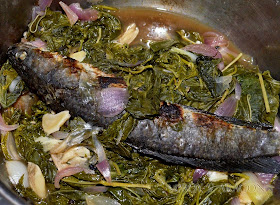Besides having kamatis as a perfect kilawen, that is the Ilokano way, being the "K" in the famous "KBL" or Ilokano's own version of the Mexican salsa, raw kamatis with bugguong and lasona (preferably the small, "native" Ilocos variety ones), well, tomato is also preferred and prepared in various ways, raw or cooked.
One of my favorites being that of the ginisa a kamatis. And of course, and still, together, with its loyal pair: bugguong & lasona. When I say bugguong, I equally consider both nabugguong a lames (salted fish/fish fermented in salt) and nabugguong nga aramang (salted shrimp paste). Fish and shrimp. For bugguong nga aramang (which by the way defines the Tagalog pakbet), it's also perfect for KBLs especially with young lasona with sweet and tender stems and leaves. I usually buy only bugguong-aramang for this purpose, and for my ginisa a kamatis.
Making this kind of appetizer dish is just so simple and easy. You sauté in oil some garlic and the lasona of course, brown and caramelize it (optionally, you can add some ginger). Then put in the bugguong-aramang (or the bugguong-lames juice if it is so), put in just a little amount of it to moderate saltiness (you can add more later to taste if the saltiness is enough for you). Stir-fry quickly and evenly, the unbearable aroma of its being bugguong will surely be so intimidating, demanding, right now as you stir it up, making you hungrier. Then add the sliced tomatoes. stir quickly and evenly, then simmer a bit. Add a pinch of sugar if you prefer, or some teaspoonfuls of tomato sauce and/or tomato catsup, optionally, to thicken it. Add some cracked peppercorns or spice it with a dash of chili powder. Do not overcook it or it becomes overly soggy and soupy and inconsistently sour. Some prefer it with more broth and add water to cook. I like it with minimal and thick sauce-like broth. Your ginisa a kamatis will be soupy if you don't remove the seeds. Removing of the seeds is optional for you, as varieties of tomatoes vary, some has watery seeds. I remove the seeds as necessary, if it's too watery.
When done, the end result would be as lovely as this:
Absolutely gorgeous! as Jamie Oliver would have to exclaim if he himself have ever tasted, and cooked, this thing of gastronomic beauty:
The fusion of saltiness, sourness, sweetness, great flavor and aroma, is a real bliss and blessing as you consume your steamed rice and main dishes with it.
One of my favorites being that of the ginisa a kamatis. And of course, and still, together, with its loyal pair: bugguong & lasona. When I say bugguong, I equally consider both nabugguong a lames (salted fish/fish fermented in salt) and nabugguong nga aramang (salted shrimp paste). Fish and shrimp. For bugguong nga aramang (which by the way defines the Tagalog pakbet), it's also perfect for KBLs especially with young lasona with sweet and tender stems and leaves. I usually buy only bugguong-aramang for this purpose, and for my ginisa a kamatis.
 |
| Naigisa a kamatis ken lasona, with bugguong nga aramang. |
When done, the end result would be as lovely as this:
Absolutely gorgeous! as Jamie Oliver would have to exclaim if he himself have ever tasted, and cooked, this thing of gastronomic beauty:
Another ginisa a kamatis, no young lasonas this time, and it's equally good and delicious:
:::::





















